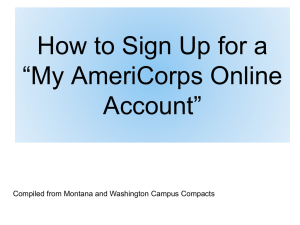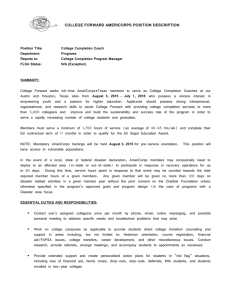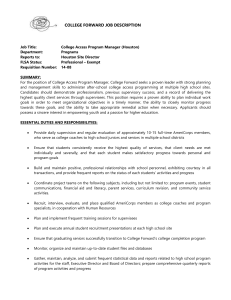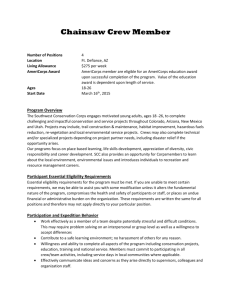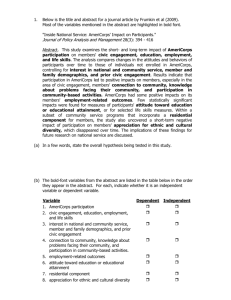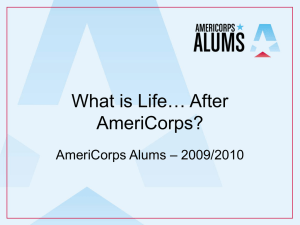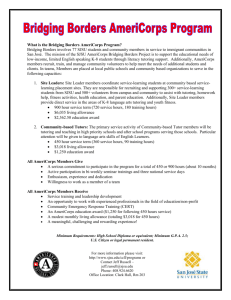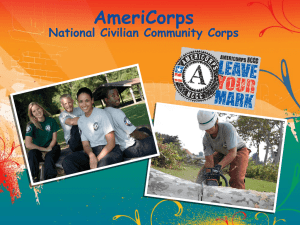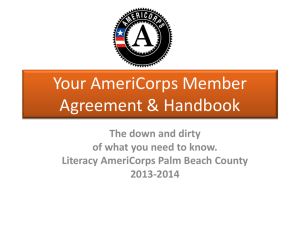At a Glance National Service Assets in Disaster - com.hb
advertisement
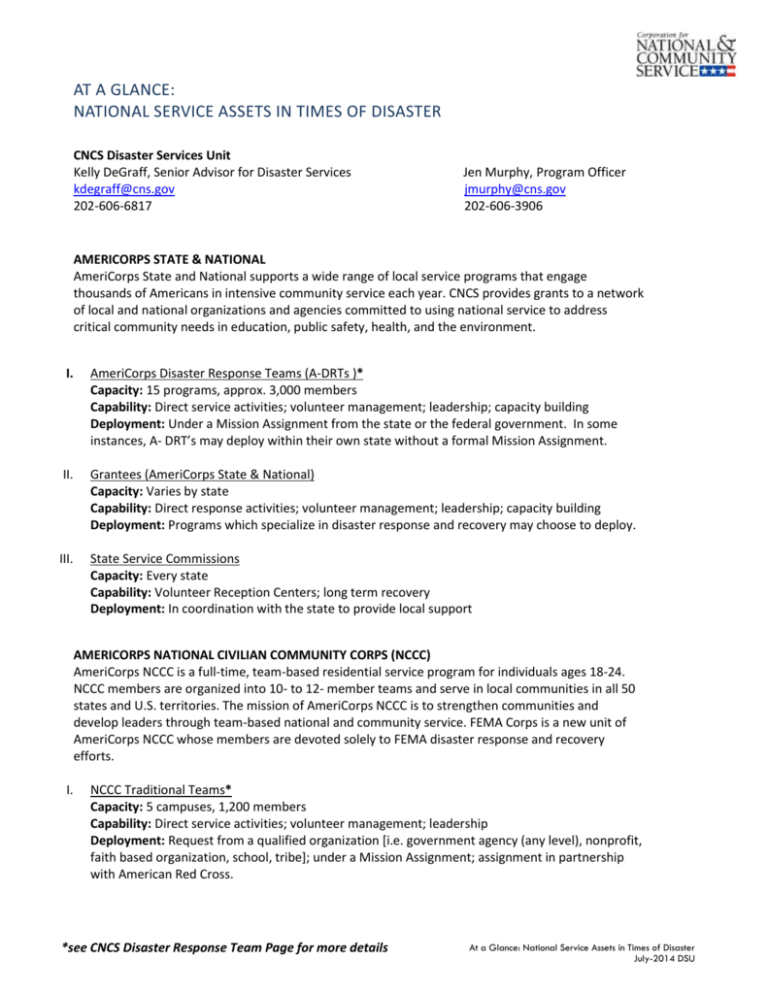
AT A GLANCE: NATIONAL SERVICE ASSETS IN TIMES OF DISASTER CNCS Disaster Services Unit Kelly DeGraff, Senior Advisor for Disaster Services kdegraff@cns.gov 202-606-6817 Jen Murphy, Program Officer jmurphy@cns.gov 202-606-3906 AMERICORPS STATE & NATIONAL AmeriCorps State and National supports a wide range of local service programs that engage thousands of Americans in intensive community service each year. CNCS provides grants to a network of local and national organizations and agencies committed to using national service to address critical community needs in education, public safety, health, and the environment. I. AmeriCorps Disaster Response Teams (A-DRTs )* Capacity: 15 programs, approx. 3,000 members Capability: Direct service activities; volunteer management; leadership; capacity building Deployment: Under a Mission Assignment from the state or the federal government. In some instances, A- DRT’s may deploy within their own state without a formal Mission Assignment. II. Grantees (AmeriCorps State & National) Capacity: Varies by state Capability: Direct response activities; volunteer management; leadership; capacity building Deployment: Programs which specialize in disaster response and recovery may choose to deploy. III. State Service Commissions Capacity: Every state Capability: Volunteer Reception Centers; long term recovery Deployment: In coordination with the state to provide local support AMERICORPS NATIONAL CIVILIAN COMMUNITY CORPS (NCCC) AmeriCorps NCCC is a full-time, team-based residential service program for individuals ages 18-24. NCCC members are organized into 10- to 12- member teams and serve in local communities in all 50 states and U.S. territories. The mission of AmeriCorps NCCC is to strengthen communities and develop leaders through team-based national and community service. FEMA Corps is a new unit of AmeriCorps NCCC whose members are devoted solely to FEMA disaster response and recovery efforts. I. NCCC Traditional Teams* Capacity: 5 campuses, 1,200 members Capability: Direct service activities; volunteer management; leadership Deployment: Request from a qualified organization [i.e. government agency (any level), nonprofit, faith based organization, school, tribe]; under a Mission Assignment; assignment in partnership with American Red Cross. *see CNCS Disaster Response Team Page for more details At a Glance: National Service Assets in Times of Disaster July-2014 DSU II. FEMA Corps Capacity: 5 campuses, 1,600 members Capability: Emergency management coordination support; capacity building; assist with specific FEMA operational tasks Deployment: FEMA identifies the need and coordinates assignment with the Disaster Services Unit, NCCC Headquarters staff, and Regional Campuses; only FEMA can request and deploy. AMERICORPS Volunteers in Service to America (VISTA) AmeriCorps VISTA members are passionate and committed to their mission to bring individuals and communities out of poverty. Members make a year-long, full-time commitment to serve on a specific project at a nonprofit organization or public agency. They focus their efforts to build the organizational, administrative, and financial capacity of organizations that fight illiteracy, improve health services, foster economic development, and otherwise assist low-income communities. I. AmeriCorps VISTA Capacity: Every state Capability: Capacity building; long term recovery; indirect service Deployment: May be redirected from their existing projects for a short amount of time if they are in the immediate impact area. SENIOR CORPS Senior Corps connects today’s 55+ with the people and organizations that need them most. Senior Corps helps them become mentors, coaches or companions to people in need, or contribute their job skills and expertise to community projects and organizations. Volunteers receive guidance and training so they can make a contribution that suits their talents, interests, and availability. I. Retired Senior Volunteer Program (RSVP) Capacity: Every state Capability: Direct service activities; leadership; capacity building; indirect service Deployment: Service activities and work plans may be modified to add additional work plans to meet new community needs caused by disaster. II. Foster Grandparents (FGP) Capacity: Every state Capability: Temporary reassignment to related work if unable to continue service due to disaster. Deployment: Service activities and work plans may be modified to add additional work plans to meet the new community need caused by disaster. III. Senior Companions (SC) Capacity: Every state Capability: Temporary reassignment to related work if unable to continue service due to disaster. Deployment: Service activities and work plans may be modified to add additional work plans to meet the new community need caused by disaster. At a Glance: National Service Assets in Times of Disaster July-2014 DSU CNCS SUPPORT AND ACTIVITIES Regardless of the size of an event, there is at least one national service program that can meet key needs in the Response and Recovery phases: RESPONSE Volunteer coordination/ operations support Operate base camps Mass care: shelter and feeding operations Community and public information outreach Warehouse and donations support Call center operations Direct services: debris removal; mucking/gutting; blue roof tarping AmeriCorps State/National Yes Yes Yes Yes Yes Yes Yes AmeriCorps NCCC Yes Yes Yes Yes Yes Yes Yes FEMA Corps No No Yes, under FEMA operations and guidance Yes, under FEMA operations and guidance No Yes Yes, through indirect service Senior Corps Yes, through indirect service Yes Yes, under FEMA operations and guidance Yes, through indirect service No AmeriCorps VISTA Yes, under FEMA operations and guidance No Yes Yes Yes Yes Yes Yes Public Facilities Renovation Needs Assessment Case Management RECOVERY Home construction/ Repair Disaster Recovery Center Support Long-Term Recovery Committees Volunteer Reception Center Support AmeriCorps State/National Yes Yes Yes Yes Yes Yes Yes AmeriCorps NCCC Yes Yes Yes Yes Yes Yes Yes FEMA Corps No No Yes, under FEMA operations and guidance Yes, under FEMA operations and guidance No No Yes Yes Yes, under FEMA operations and guidance Yes No AmeriCorps VISTA Senior Corps Yes, under FEMA operations and guidance Yes Yes Yes Yes Yes Yes Yes No Yes, through indirect service Yes At a Glance: National Service Assets in Times of Disaster July-2014 DSU CNCS AmeriCorps Disaster Response Teams (A-DRT’s) AmeriCorps Disaster Response Teams (A-DRTs) are the AmeriCorps programs that have a heightened focus on disaster response service and are a nationally deployable resource. Capacity: CNCS currently has 16 A-DRTs, made up of 14 AmeriCorps grantees/sub-grantees, 1 State Service Commission, and AmeriCorps NCCC; this totals to access to over 4,200 AmeriCorps members. Training: A-DRTs are trained in disaster services functions to include: Incident Command; CPR/First Aid; Volunteer and Donations Management; Mass Care/Family Services; Shelter Operations; OSHA certified Chainsaw Training; Hazmat certification. Individual Assistance: Public Assistance: Volunteer and Donations Management: Community Outreach: Capacity Building: Distribution of Life-Sustaining Supplies; Support for Mass Care (Sheltering; Feeding); Health and Wellness Checks Direct Service: Mucking and Gutting; Debris clean-up; Emergency Roof Tarping; Emergency Home Repair; Mold Suppression; Hazard Tree Removal/Chainsaw; Minor home repair Critical Debris Removal; Flood Fighting (Sandbagging, etc.); Dispatch and Tracking of Donated Equipment; Park and Public Lands Restoration Volunteer Reception Center: Establish and Manage Operations; Database Management; Damage assessments; Track Volunteer Hours (can be used for State soft match) Field Leadership for Volunteers: Deliver safety and task training; Support volunteer logistics Donations: Warehousing Support; POD and Donations Tracking Damage and Other Needs Assessment; Support to 2-1-1 or Other Call Centers; Client Intake and Tracking; Public Situational Awareness; Case Management; Support for MARCs; Transportation; Staffing for Staging Areas and Logistics; Canvassing Support to Emergency Management; Support to VOAD, COADs, and LTRCs; Inter-agency Facilitation; Surge Capacity for Staffing; Support for Emergency Farm and Animal Care Understanding the different A-DRT Programs: AmeriCorps Grantees and AmeriCorps NCCC Within the A-DRT are two different AmeriCorps programs: AmeriCorps State and National grantees and AmeriCorps NCCC. The two programs are capable of the same basic direct services in disaster response, with each individual program having a varied level of experience and expertise. However, programmatically there are some differences between the two programs outlined below: Program Structure and Capacity AmeriCorps State and National Grantees AmeriCorps NCCC Team size 6-8 member crews; capable of adjusting crew size if needed, including single resource deployments 8-12 member teams; teams are fixed size Program Vehicles Supervision Housing Typically 2 pickup trucks/SUVs Crew leader (AmeriCorps or paid staff member) Self-sufficient for initial arrival; able to identify housing partners 1 GSA 15-passenger van Team Leader (AmeriCorps member) Require housing identified before deployment Sponsor/Hosting Organization Self-sufficient for initial arrival; able to identify local organizations to partner Require work sponsor and site supervisor identified before deployment Personnel Costs Fee for service programs Fully federally funded; no fee for service At a Glance: National Service Assets in Times of Disaster July-2014 DSU
